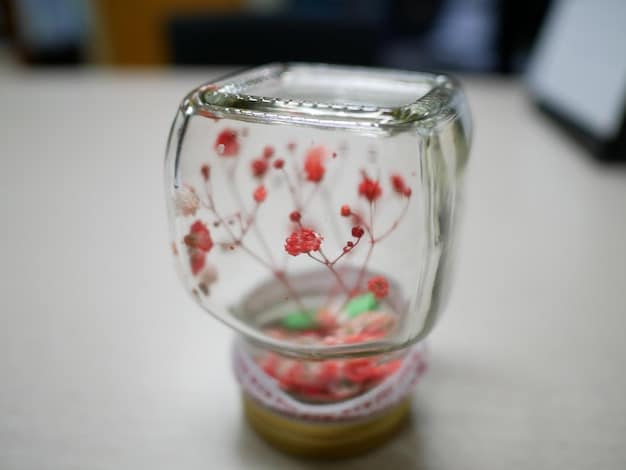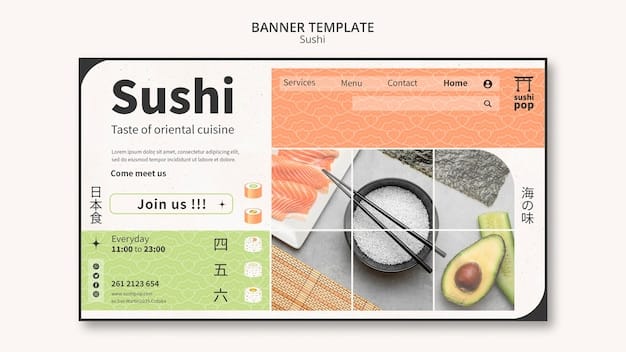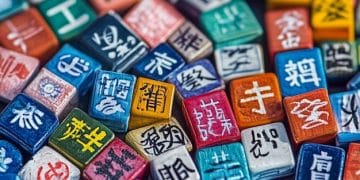Decoding Japanese Product Labels: 2025 Guide for US Shoppers

Decoding Japanese product labels is crucial for US shoppers in 2025 to avoid counterfeits and ensure they’re getting the authentic products they expect, while also understanding ingredients, safety information, and maximizing value for their purchases.
Navigating the world of Japanese products can be exciting, but also a bit daunting, especially when trying to decipher those unfamiliar labels. This 2025 guide, **decoding Japanese product labels**, is designed for US shoppers like you, helping you avoid counterfeit goods and get the most value from your purchases.
Understanding the Importance of Japanese Product Labels for US Consumers
For US consumers venturing into the realm of Japanese products, product labels are more than just decorative elements; they are a gateway to understanding the product’s authenticity, safety, and intended use. With the rise of e-commerce and global marketplaces, the risk of encountering counterfeit products has increased, making it crucial to be able to decipher Japanese labels.
This section will delve into why understanding Japanese product labels is essential for US consumers, especially in 2025, focusing on how this knowledge can help avoid counterfeits and maximize product value.
The Rising Concern of Counterfeit Japanese Products
The global market is flooded with counterfeit products, and Japanese goods are no exception. These fake items often lack the quality control and safety standards of genuine products, posing potential health risks to consumers.
Being able to identify key indicators on Japanese product labels can help US shoppers differentiate between authentic and fake products, ensuring they are purchasing safe and high-quality items.
- Recognizing authentic Japanese certifications: Look for specific seals and marks that indicate the product has been certified by Japanese regulatory bodies.
- Checking for manufacturer information: Authentic labels usually include detailed manufacturer information, including the company name, address, and contact details.
- Comparing prices with reputable retailers: Counterfeit products are often sold at significantly lower prices than genuine goods, which should raise a red flag.
Successfully navigating Japanese product labels is empowering American shoppers to verify the genuineness of products, reducing the chances of purchasing fakes and safeguarding their health and well-being.
Key Elements of Japanese Product Labels: A Visual Guide
Japanese product labels may initially appear bewildering to US consumers due to the language barrier and unfamiliar symbols. However, by understanding the key elements typically found on these labels, American shoppers can navigate them with greater confidence. This section will provide a visual guide to the essential components of Japanese product labels, helping you interpret their meaning and significance.
Let’s break down some common symbols, phrases, and layouts you might encounter:
One prominent element is the product name (製品名 – Seihinmei), which is usually written in large, bold characters on the front of the package. Understanding how to search for the product name online as well.

Another critical aspect is the list of ingredients (原材料名 – Genzairyoumei), which is typically listed in descending order by weight. Recognizing common allergens and additives is crucial for those with dietary restrictions or sensitivities.
The expiration date (消費期限 – Shoumikigen or 賞味期限 – Shoumikigen) is imperative for food and beverage products, indicating the date after which the product is no longer safe to consume or has passed its optimal quality. Ensure you locate and understand this date before using any food item, particularly food items.
Decoding Specific Symbols and Markings
Japanese product labels often feature specific symbols and markings that provide additional information about the product. These can include recycling symbols, quality assurance marks, and safety warnings.
Familiarizing yourself with these symbols can help you to make informed decisions and ensure the product is safe for your intended use.
- Recycling Symbols (リサイクルマーク): These symbols indicate the type of material the packaging is made from and how it can be recycled.
- JIS Mark (JISマーク): This mark certifies that the product meets the standards set by the Japanese Industrial Standards Committee.
- Safety Warnings (注意): These warnings alert consumers to potential hazards associated with the product’s use.
Having a strong understanding of these common aspects of Japanese product labels will dramatically improve the safety of US consumers.
Navigating Food Labels: Ingredients, Allergens, and Nutritional Information
Japanese food labels can be particularly tricky for US consumers due to the complex kanji characters and unfamiliar food additives. This section will focus on navigating Japanese food labels, providing guidance on how to identify ingredients, allergens, and nutritional information.
Understanding these are crucial for US consumers with dietary restrictions, allergies, or those simply seeking to make informed food choices. Fortunately, we have lots to share about how to decipher these.
The list of ingredients (原材料名 – Genzairyoumei) is typically written in Japanese, but some labels may include a Romanized version (Romaji) or English translation. Pay close attention to this list, as it provides a comprehensive overview of the product’s composition.

Common allergens, such as wheat (小麦 – Komugi), eggs (卵 – Tamago), milk (牛乳 – Gyuunyuu), and peanuts (ピーナッツ – Piinattsu), are often indicated with bold text or specific symbols. If you have a known allergy, carefully review the ingredient list before consuming the product.
For those managing sodium intake, keep an eye on the sodium content (ナトリウム – Natoriumu). Multiply the sodium amount by 2.5 to estimate the equivalent amount of salt. Also, note that sugar (砂糖 – Satou) and fats (脂質 – Shishitsu) are listed in grams.
Resources for Translating Food Labels
Even with a basic understanding of Japanese food labels, some ingredients or additives may remain unfamiliar. Thankfully, a variety of resources are available to help US consumers translate these labels.
These tools can help you decipher unfamiliar terms and make informed decisions about the food you consume.
- Smartphone Translation Apps: Apps like Google Translate allow you to scan text in real-time and receive an instant translation.
- Online Dictionaries: Online dictionaries like Jisho.org can be used to look up individual words or phrases found on the label.
- Specialized Food Label Translation Guides: Websites and blogs dedicated to Japanese food offer comprehensive translation guides and explanations of common ingredients and additives.
In short, knowing how to read ingredients, identify allergens, and use translation resources empowers American consumers to enjoy Japanese cuisine safely and responsibly.
Decoding Cosmetics and Skincare Labels: Safety and Usage
Japanese cosmetics and skincare products are renowned for their high quality and effectiveness, but their labels can be daunting for US consumers unfamiliar with Japanese terminology. This section will focus on decoding cosmetics and skincare labels, providing insights into safety information, usage instructions, and potential allergens. While these products have numerous benefits, using them safely is key.
Because the skin quickly absorbs chemicals, knowing how to read skincare can be crucial for ensuring you are not getting products that contain harmful ingredients.
The list of ingredients (成分 – Seibun) is usually listed in Japanese, but some products may include a Romanized version (Romaji) or English translation. Pay close attention to this list. Ingredients with known safety concerns will be prominently displayed.
Expiration dates (使用期限 – Shiyoukigen) are often indicated on cosmetics and skincare products to ensure optimal quality and effectiveness. Pay attention to this date and avoid using products that have expired.
Identifying Potential Irritants and Allergens in Cosmetics
Cosmetics and skincare products can contain ingredients that may cause irritation or allergic reactions in sensitive individuals. It’s essential to identify these potential irritants and allergens to avoid adverse reactions.
When purchasing Japanese cosmetics and skincare products, check the labels for common irritants and allergens. These may cause you to react poorly to the product, so use with caution.
- Parabens (パラベン): These preservatives are sometimes linked to skin irritation and hormone disruption.
- Artificial Fragrances (香料): These fragrances can cause allergic reactions in some individuals.
- Alcohol (アルコール): This ingredient can dry out the skin and cause irritation.
Reading labels thoroughly, especially for those with sensitive skin, and using translation apps or online guides is the key to safety.
Avoiding Counterfeits: Red Flags and Verification Tips
The market for Japanese products, particularly cosmetics, skincare, and electronics, is rife with counterfeit goods. These fake items often lack the quality control and safety standards of authentic products, posing potential health risks to consumers. This section outlines red flags to look for and verification tips to help US shoppers avoid purchasing counterfeit Japanese products.
Because counterfeit products tend to be of a poorer quality, you may notice a clear difference between real and fake.
One of the most obvious red flags is an unusually low price. Counterfeit products are often sold at significantly lower prices than genuine goods. If a price seems too good to be true, it likely is.
Examine the packaging closely for any signs of poor quality, such as blurry text, misaligned labels, or missing information. Authentic products typically have high-quality packaging with clear, crisp printing.
Utilizing Online Resources for Verification
The internet can be a valuable tool for verifying the authenticity of Japanese products. Numerous online resources are available to help US shoppers spot fake items.
In order to verify a product, make sure you are aware of the resources available.
- Manufacturer Websites: Check the manufacturer’s official website for product information, images, and authentication guides.
- Online Forums and Communities: Join online forums and communities dedicated to Japanese products. These platforms often share tips and information on identifying counterfeit goods.
- Third-Party Authentication Services: Consider using third-party authentication services that specialize in verifying the authenticity of luxury goods.
As always, shopping with reputable retailers is always a good idea.
Maximizing Value: Understanding Pricing and Sales
While the allure of Japanese products is undeniable, smart shopping is crucial to maximize value and avoid overpaying. This section provides guidance on understanding pricing strategies and taking advantage of sales opportunities to make the most of your budget when purchasing Japanese goods which, due to international shipping, are already pricey.
Pricing is a complex issue, but this guide will help demystify the process
Understanding the currency exchange rate between the US dollar and the Japanese yen is essential for evaluating prices accurately. Familiarize yourself with the current exchange rate to avoid overpaying.
Compare prices across multiple retailers, both online and offline, before making a purchase. Different retailers may offer different prices, so it’s wise to shop around.
Leveraging Seasonal Sales and Promotions
Take advantage of seasonal sales and promotions to get the best deals on Japanese products. Many retailers offer discounts during specific times of the year, such as New Year’s, Golden Week, and Black Friday.
Seasonal sales and promotions are often useful, but here are some common promotions to look out for:
- New Year’s Sales (新年セール): These sales typically offer significant discounts on a wide range of products.
- Golden Week Sales (ゴールデンウィークセール): This week-long holiday in Japan often triggers sales and promotions.
- Black Friday and Cyber Monday Sales: Many online retailers offer discounts on Japanese products during these major shopping events.
In closing, we must emphasize the importance of doing research before buying Japanese goods to get the most value for your purchase.
| Key Point | Brief Description |
|---|---|
| 🔍 Reading Labels | Essential for understanding product details and safety. |
| 🛡️ Avoiding Fakes | Look for authentic certifications and compare prices. |
| 💰 Maximizing Value | Leverage seasonal sales and compare retailer prices. |
| Allergy Checks | Know which allergies (eggs, dairy, nuts) and additives to avoid. |
Frequently Asked Questions
▼
Common symbols include recycling marks, the JIS mark (indicating Japanese Industrial Standards), and various safety warnings such as “caution” marks for potential hazards.
▼
Look for allergen warnings, as ingredients like wheat, eggs, milk, and peanuts are often indicated with bold text or specific symbols if they’re present in the product.
▼
Red flags include an unusually low price, poor packaging quality, blurry text, misaligned labels, and the absence of details like manufacturing information.
▼
Check the ingredients list for known irritants like parabens or artificial fragrances and pay attention to expiration dates to ensure the product is still effective and safe.
▼
Use manufacturer websites, online forums, social media, and third-party authentication services to vet out and investigate for the product’s authentication and credibility.
Conclusion
Decoding Japanese product labels is becoming more critical for US shoppers, especially as the global market grows in complexity. With the rise of e-commerce and potential for counterfeit products, this guide offers essential insights into identifying key elements on Japanese labels, thereby ensuring authenticity, safety, and value. By focusing on ingredients, expiration dates, and verification methods, American consumers can confidently navigate the world of Japanese products, making informed purchasing decisions that prioritize both quality and well-being.





